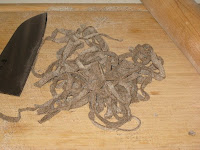
Our friend Harris Salat is working on nabe cookbook with Tadashi Ono of Matsuri. We volunteered to be recipe testers. What could be better work? Test the recipe and then eat what we've made!
We had already tested the recipes for Chicken Nabe and Lamb Nabe. Our assignment this time was to make Duck Dumpling Nabe. The recipe called for duck legs for making duck dumplings. When we went to our local butcher, who informed us that they don't sell that particular part of duck by itself. We had to buy a whole duck. Since we didn't want to buy an entire duck, we decided to make the dumplings using duck breast. We bought a piece of duck breast for the dumplings and a duck breast for slicing to cook in the nabe.

Hiroko put the chopped duck breast and seasonings in the blender to chop the meat. She then added buckwheat flour and eggs to the meat and then pulsed the meat into a gooey mixture.
 When slicing meat thinly, we've found that freezing the meat beforehand is a great trick and we use it often. After freezing a duck breast she cut it in half, removed the fat, and left the fat on the other half. She then thinly sliced the both.
When slicing meat thinly, we've found that freezing the meat beforehand is a great trick and we use it often. After freezing a duck breast she cut it in half, removed the fat, and left the fat on the other half. She then thinly sliced the both.
Next, she boiled the water, konbu, shoyu, and mirin in the nabe pot, scooped up handfuls of the blended seasoned duck mixture and dropped into the boiling liquid. Once these "duck dumplings" floated to surface, she added tofu, negi, hakusai, shirataki, and enoki mushrooms. It was then time to cover the pot with its lid and wait while everything cooked.
The last step was to add Shungiku on the top and the nabe was done.
 Once we were at the table, we cooked the thinly sliced duck in the hot nabe and "chowed down." It was delicious! We tried two dramatically different sake with the dish: Denshu Tokubetsu Junmai and Narutotai Ginjo Nama Genshu. With the vegetables and duck dumplings, the Denshu was great match. With thin sliced duck with fat, Narutotai Ginjo Nama Genshu was the perfect match. While we were fortunate to be able to have both to enjoy with each portion of the meal, it isn't necessary to have two sake with this dish!
Once we were at the table, we cooked the thinly sliced duck in the hot nabe and "chowed down." It was delicious! We tried two dramatically different sake with the dish: Denshu Tokubetsu Junmai and Narutotai Ginjo Nama Genshu. With the vegetables and duck dumplings, the Denshu was great match. With thin sliced duck with fat, Narutotai Ginjo Nama Genshu was the perfect match. While we were fortunate to be able to have both to enjoy with each portion of the meal, it isn't necessary to have two sake with this dish!For shime (the carb of our choice in the end of nabe), we threw in soba and slurped it after it had cooked in the delicious duck-flavored broth. You couldn't find a better dish to have on a chilly winter evening! We can't wait to see this book on the market so that more people can experience the pleasure of eating nabe in their own homes.





